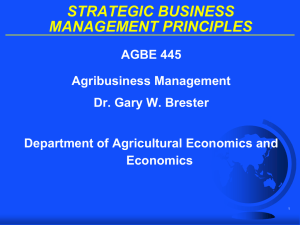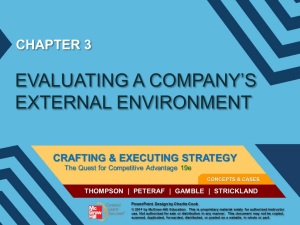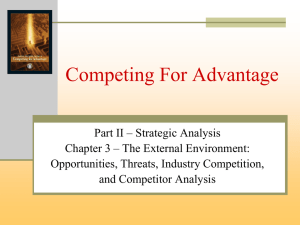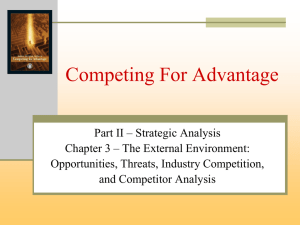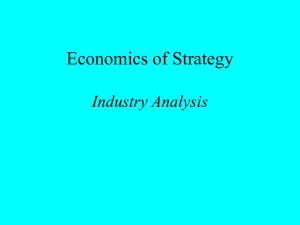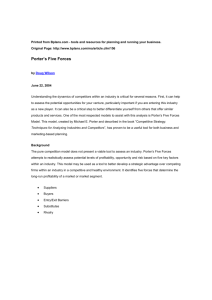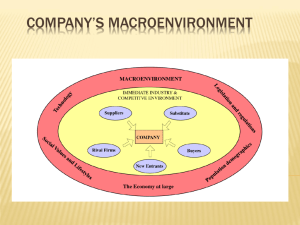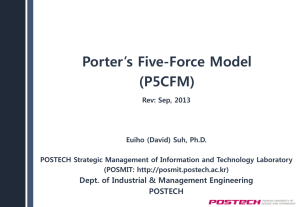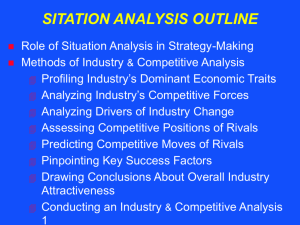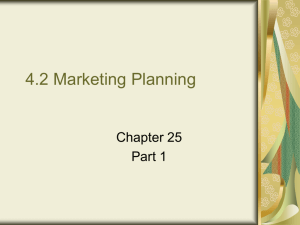External Environment for Value Creation
advertisement
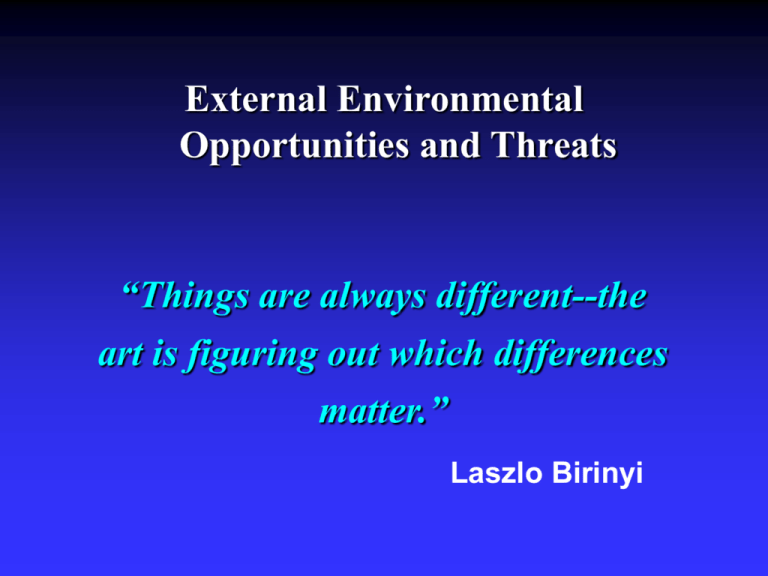
External Environmental Opportunities and Threats “Things are always different--the art is figuring out which differences matter.” Laszlo Birinyi Three Levels of Analysis MACROENVIRONMENT The Economy at Large Suppliers Rival Firms Substitutes COMPANY New Entrants IMMEDIATE INDUSTRY AND COMPETITIVE ENVIRONMENT Buyer s Question 1: What are the Industry’s Dominant Economic Traits? Market size and growth rate Scope of competitive rivalry Number of competitors and their relative sizes Prevalence of backward/forward integration Entry/exit barriers Nature and pace of technological change Product and customer characteristics Scale economies and experience curve effects Capacity utilization and resource requirements Industry profitability Table 3.2: Relevance of Key Economic Features Economic Feature Strategic Importance Market growth rate Small markets don’t tend to attract new firms; large markets attract firms looking to acquire rivals with established positions in attractive industries Fast growth breeds new entry; slow growth spawns increased rivalry & shakeout of weak rivals Capacity surpluses/shortages Surpluses push prices & profit margins down; shortages pull them up Industry profitability High-profit industries attract new entrants; depressed conditions lead to exit Entry/exit barriers High barriers protect positions and profits of existing firms; low barriers make existing firms vulnerable to entry Product is big-ticket item for buyers More buyers will shop for lowest price Standard products Buyers have more power because it’s easier to switch from seller to seller Rapid technological change Vertical integration Raises risk; investments in technology facilities/equipment may become obsolete before they wear out Big requirements make investment decisions critical; timing becomes important; creates a barrier to entry and exit Raises capital requirements; often creates competitive & cost differences among fully vs. partially vs. non-integrated firms Economies of scale Increases volume & market share needed to be cost competitive Rapid product innovation Shortens product life cycle; increases risk because of opportunities for leapfrogging Market Size Capital requirements Macroenvironmental Forces Political-Legal Forces Include the outcomes of elections, legislation, and court judgments, as well as decisions rendered by various commissions and agencies at every level of government. Economic Forces Forces that have a significant impact on business operations, such as the GDP, interest rates, inflation rates, and the value of the dollar. Macroenvironmental Forces Technological Forces Include scientific improvements and innovations that provide opportunities or threats for business. Social Forces Include traditions, values, societal trends, demographic trends, and a society’s expectations of business. Assessing Industry Attractiveness Four primary analyses Assess strength of each of Porter’s five forces (Strong? Moderate? Weak? ) Porter’s Five Forces Driving Forces Key Success Factors Competitive Analysis Rivalry among competitors Substitute products Potential entry Bargaining power of suppliers Bargaining power of buyers Explain how each force acts to create competitive pressure Decide whether overall competition is brutal, fierce, strong, normal/moderate, or weak Rivalry Among Competing Sellers Usually the most powerful of the five forces Check which weapons of competitive rivalry are most actively used by rivals in jockeying for position Price Quality Performance features offered Customer service Warranties/guarantees Advertising/promotions Dealer networks Product innovation Competitors number and strength Threat of New Entrants How hard is it to get into the industry? Economies of scale Product differentiation Capital requirements Learning curve effects Access to distribution channels Government policies Control of key raw materials Inability to gain access to specialized technology Threat of Substitutes Substitutes matter when customers are attracted to the products of firms in other industries Examples Eyeglasses vs. Contact Lens Sugar vs. Artificial Sweeteners Plastic vs. Glass vs. Metal Newspapers vs. TV vs. Internet Threat of Suppliers Suppliers are a strong competitive force when: Item makes up large portion of product costs, is crucial to production process, and/or significantly affects product quality It is costly for buyers to switch suppliers They have good reputations and growing demand They can supply a component cheaper than industry members can make it themselves They do not have to contend with substitutes Buying firms are not important customers Threat of Buyers Buyers are a strong competitive force when: They are large and purchase a sizable percentage of industry’s product They buy in volume quantities They can integrate backward Industry’s product is standardized Their costs in switching to substitutes or other brands are low They can purchase from several sellers Product purchased does not save buyer money Strategic Implications of the Five Competitive Forces Competitive environment is unattractive from the standpoint of earning good profits when: Rivalry is strong Entry barriers are low and entry is likely Competition from substitutes is strong Suppliers and customers have considerable bargaining power Strategic Implications of the Five Competitive Forces Competitive environment is ideal from a profit-making standpoint when: Rivalry is moderate Entry barriers are high and no firm is likely to enter Good substitutes do not exist Suppliers and customers are in a weak bargaining position Driving Forces Industries change because forces are driving industry participants to alter their actions Driving forces are the major underlying causes of changing industry and competitive conditions Examples •Changes in long-term industry growth rate •Changes in who buys the product and how they use it •Product innovation •Technological change/process innovation •Marketing innovation •Entry or exit of major firms •Diffusion of technical knowledge Key Success Factors KSFs are competitive elements that most affect every industry member’s ability to prosper in the marketplace Specific strategy elements Product attributes Resources Competencies Competitive capabilities KSFs spell difference between Profit and loss Competitive success or failure Table 3.3: Common Types of Key Success Factors Scientific research expertise; Product innovation capability; Expertise in a given technology; Capability to use Internet to conduct various business activities Manufacturing- Low-cost production efficiency; Quality of manufacture; High use of fixed assets; Low-cost plant locations; High labor productivity; Lowrelated cost product design; Flexibility to make a range of products Strong network of wholesale distributors/dealers; Gaining ample Distributionspace on retailer shelves; Having company-owned retail outlets; Low related distribution costs; Fast delivery Fast, accurate technical assistance; Courteous customer service; MarketingAccurate filling of orders; Breadth of product line; Merchandising related skills; Attractive styling; Customer guarantees; Clever advertising Superior workforce talent; Quality control know-how; Design expertise; Expertise in a particular technology; Ability to develop Skills-related innovative products; Ability to get new products to market quickly Organizational Superior information systems; Ability to respond quickly to shifting market conditions; Superior ability to employ Internet to conduct capability business; More experience & managerial know-how Favorable image/reputation with buyers; Overall low-cost; Convenient locations; Pleasant, courteous employees; Access to financial capital; Other types Patent protection Technologyrelated Identifying Industry Key Success Factors Answers to three questions pinpoint KSFs On what basis do customers choose between competing brands of sellers? What resources and competitive capabilities does a seller need to have to be competitively successful? What does it take for sellers to achieve a sustainable competitive advantage? KSFs consist of the 3 - 5 really major determinants of financial and competitive success in an industry Things to Consider in Assessing Industry Attractiveness Industry’s market size and growth potential Whether competitive conditions are conducive to rising/falling industry profitability Will competitive forces become stronger or weaker Whether industry will be favorably or unfavorably impacted by driving forces Potential for entry/exit of major firms Stability/dependability of demand Severity of problems facing industry Degree of risk and uncertainty in industry’s future My Mom!

